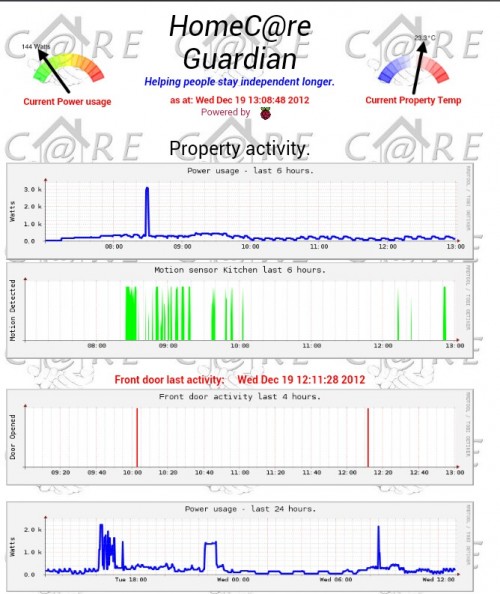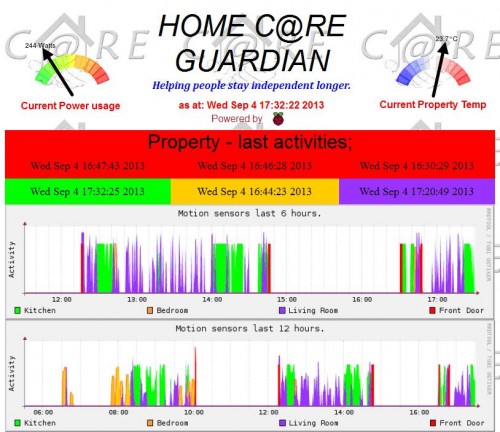| Several people have mentioned the idea of using the Pi to help relatives and carers support older people in their own homes by monitoring aspects of their daily routine as well as things like the indoor temperature, but until now, we hadn’t seen anyone write up a system they’d implemented. So we were very interested when we received an email from Jamie Grant, telling us how he had used a Raspberry Pi-based home monitoring system to help him support his late mother in maintaining her independence.
An early Pi adopter, one of Jamie’s first projects was home power monitoring. After installing a system to plot electricity usage in his own home using CurrentCost hardware and a Raspberry Pi, he was struck by the “kettle spike”, a power spike that shows clearly that someone is up and making tea. His mother was very elderly, was living alone and had a worsening serious illness, and it occurred to him that the kettle spike would provide a useful indication that she was OK. He decided to install the system at her house, adding some wireless PiR (passive infrared) motion and door sensors. Jamie called this first version HomeCare Guardian; power and sensor data were displayed in a simple webpage. Here’s another screenshot, showing the system in 2013, after about a year of development:
From this single page, Jamie could see whether his mum was OK and going about her usual daily routine, and a sensor at the front door indicated when she took a taxi journey to visit her friends and when she returned. He says,
Jamie has continued working on the wireless sensors and their power requirements: his latest PiR motion sensor is powered by just two AA batteries and has a battery life of over a year, and his new door sensor has an estimated battery life of over three years. With sensors for motion, door opening, indoor temperature and water (to provide flood alerts) ready to go, he hopes to add a humidity sensor soon. The same system, he observes, could also be used for checking an unoccupied property for flood or frost risk as well as other aspects of security. Very recently he has been working with an Android app developer, and they’re hoping to add an alerts app facility soon. The system has been renamed as Pi HomeGuard, and you can see a working live site, all running off a Raspberry Pi, at www.pihomeguard.com. Jamie is interested in taking this prototype further and making it more widely available, and would be glad to make contact with people who’d like to become involved; if this describes you, say so in the comments, and we’ll put you in touch. |
A Semi-automated Technology Roundup Provided by Linebaugh Public Library IT Staff | techblog.linebaugh.org
Friday, December 19, 2014
Pi HomeGuard: helping people stay independent longer
Subscribe to:
Post Comments (Atom)


No comments:
Post a Comment